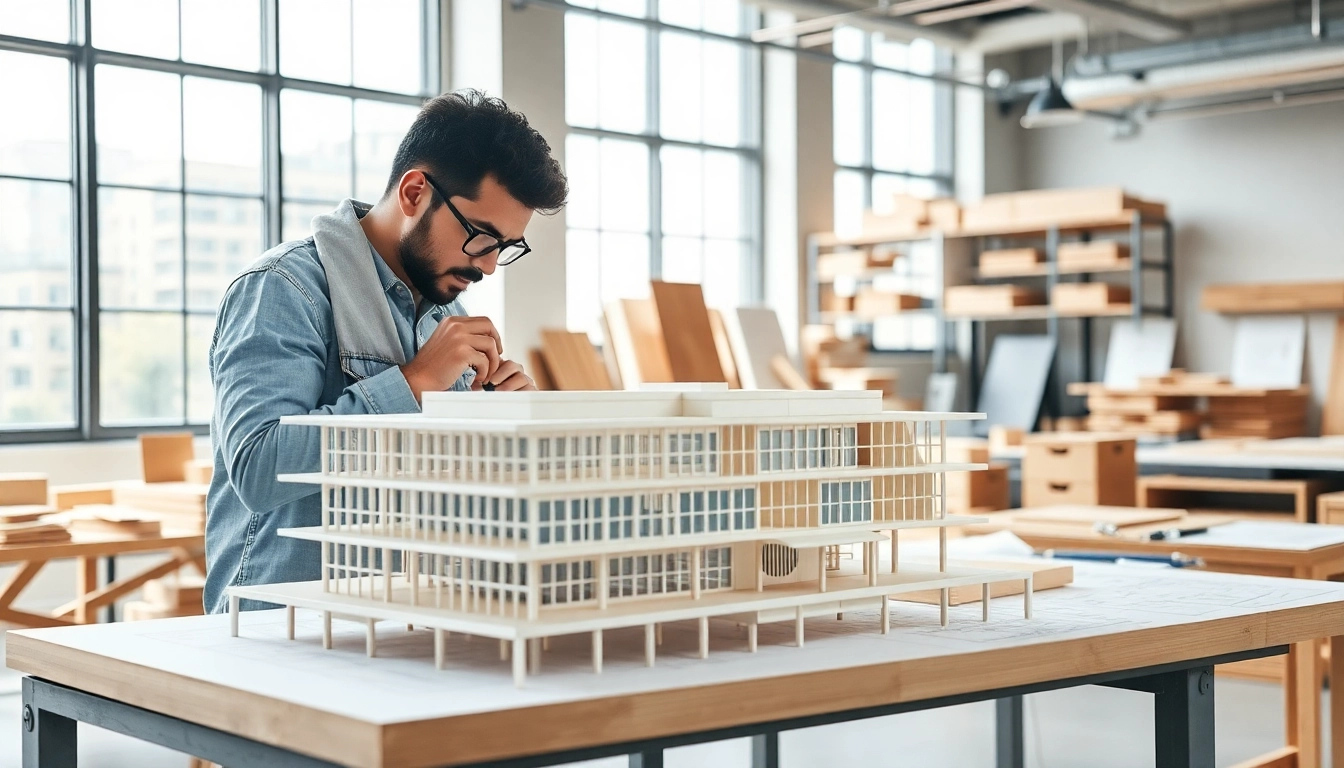Understanding the Real Estate Model Abu Dhabi Landscape
Abu Dhabi’s real estate market has seen significant transformation over the past decade, becoming a focal point for both local and international investors. As development thrives in this emirate, the need for high-quality real estate model Abu Dhabi has become increasingly important. These models not only provide a visual representation of potential developments but also serve as crucial tools for stakeholders in making informed investment decisions. In this article, we will explore the various aspects of the real estate model landscape in Abu Dhabi, focusing on trends, key features, and the significance of architectural models for investors.
Overview of Abu Dhabi’s Real Estate Market Trends
Abu Dhabi’s real estate market displays a blend of resilience and dynamic growth, largely influenced by economic factors such as oil revenues, population growth, and strategic diversification efforts. As per recent reports, property prices and rental yields are on an upward trajectory, attributing to more demand across various segments from luxury to mid-range housing. For example, the latest forecasts indicate residential property prices will rise by approximately 3% to 5% over the next twelve months.
Key Features of Real Estate Models in Abu Dhabi
Real estate models in Abu Dhabi are characterized by several key features that set them apart from traditional architectural models. Notably, the integration of advanced technology, including virtual reality (VR) and augmented reality (AR), allows investors to experience a project’s feel and functionality before completion. Additionally, these models often highlight sustainable design principles, showcasing eco-friendly solutions that align with Abu Dhabi’s commitment to sustainable development.
Significance of Architectural Models for Investors
Architectural models serve as a vital tool for investors, enabling them to visualize projects in a tangible way. For potential buyers, seeing a three-dimensional representation of a property can significantly enhance understanding and emotional connection to the investment. Furthermore, models allow for detailed examination of layouts, amenities, and environmental integration, fostering confidence in purchase decisions.
Current Market Dynamics and Factors Influencing Models
Economic Influences on Real Estate Models
The economic landscape of Abu Dhabi is a pivotal factor influencing real estate models. The emirate’s economy has been buoyed by key industries such as oil and gas, tourism, and finance. Consequently, fluctuations in oil prices can directly impact real estate investment patterns, leading to heightened interest or hesitation. For instance, the introduction of competitive pricing has opened new markets to overseas investors looking for value. Real estate models, therefore, must remain adaptable to reflect economic shifts and investor sentiments.
Technological Advancements in Model Construction
Innovation is at the forefront of model construction in Abu Dhabi. Technology is reshaping how models are built, with 3D printing emerging as a popular method for creating highly detailed and accurate structures. This technology not only streamlines the production process but also reduces costs associated with traditional methods. Additionally, the use of Building Information Modeling (BIM) allows for collaborative work among architects, investors, and city planners, ensuring that models align closely with development goals and zoning regulations.
Impact of Government Policies on Real Estate Modeling
Government policies play an influential role in shaping the real estate landscape of Abu Dhabi. Initiatives aimed at encouraging foreign investment, such as the introduction of long-term visas for expatriates, have stimulated demand across all property sectors. Emerging regulations regarding sustainability and environmental standards further compel developers and investors to emphasize eco-conscious designs in their models. Understanding these policies is essential for stakeholders aiming to align their projects with governmental expectations and community needs.
Types of Real Estate Models Commonly Used
Residential vs Commercial Real Estate Models in Abu Dhabi
In the realm of real estate modeling, residential and commercial properties necessitate different approaches. Residential models often emphasize aesthetics, layout, and functionality, appealing to families and individual buyers. In contrast, commercial models are more focused on maximizing utility and profitability; thus, they prioritize space optimization and operational efficiency. This distinction is critical when creating models that convince stakeholders and investors of the viability of a given project.
Scale Models vs Digital Renderings
Two primary types of models have gained prominence in Abu Dhabi: scale models and digital renderings. Scale models provide a physical representation of a property, which can enhance understanding of the spatial relationships and design intricacies. Meanwhile, digital renderings allow for flexibility and rapid adjustments, making them particularly attractive for showcasing projects during the pre-construction phase. Both types are essential to a holistic approach in real estate evaluation, each serving unique purposes in the communication of project visions.
The Role of 3D Printing in Model Development
3D printing has emerged as a game-changer in the development of real estate models. This technology allows for rapid prototyping and fine detail that would be difficult to achieve with traditional craftsmanship. Moreover, it lowers material waste and speeds up the time from concept to model. Investor interest in sustainable practices has added further incentive to adopt 3D printing methods, which enable firms to prototype designs with eco-friendly materials that reflect current industry standards.
Best Practices for Creating Effective Real Estate Models
Essential Elements of High-Quality Models
Creating effective real estate models requires careful attention to detail and quality. High-quality models should encompass accurate representations of architecture, materials, and finishes, alongside thoughtful landscape integration. Furthermore, the models must be scalable, providing options for viewers to appreciate both the large-scale context and minute details.
Cost Considerations When Designing Models
Budgeting for real estate model construction is crucial for ensuring projects remain financially viable. Costs can vary significantly based on model complexity, materials used, and technology implemented. Therefore, stakeholders must conduct cost-benefit analyses before embarking on model development, weighing the value these models provide against projected spending. Continuous communication between stakeholders regarding expectations and budgetary constraints can aid in achieving financially feasible solutions.
Common Mistakes to Avoid in Real Estate Modeling
Several pitfalls can hinder the effectiveness of real estate models. One common mistake is neglecting to update models in accordance with changing designs or project details, which can lead to miscommunication among stakeholders. Additionally, assuming all investors are familiar with real estate terminology can create barriers to understanding. Acknowledging and addressing varying levels of expertise among potential buyers is crucial for ensuring all parties appreciate the models presented. Regular feedback throughout the modeling process can also help in avoiding these and other common issues.
Future Prospects of Real Estate Models in Abu Dhabi
Emerging Trends: Sustainability in Real Estate Modeling
As sustainable development takes center stage globally, the trend is similarly reflected in Abu Dhabi’s real estate market. Architectural models are increasingly incorporating elements that reflect sustainability, including energy-efficient systems and the use of sustainable materials. Emerging trends such as zero-emission buildings and greening existing urban landscapes further highlight the importance of adaptive models that espouse environmentally friendly practices.
How Investment Patterns Influence Model Design
Recognizing the evolving investment patterns within Abu Dhabi’s real estate sector can inform model design significantly. For example, an increase in demand for luxury apartments or eco-friendly housing can prompt developers to create enhanced models that align with these consumer trends. The ability to adapt models quickly based on market demand is vital for remaining competitive in the ever-changing landscape.
Predictions for the Real Estate Model Market Over the Next Decade
Looking ahead, the real estate model market in Abu Dhabi is poised for continued growth. Factors such as the increasing sophistication of investors, ongoing governmental support for the sector, and a growing appetite for innovative construction techniques will drive demand for high-quality models. Additionally, as virtual and augmented reality technologies continue to advance, real estate models will increasingly become interactive experiences, allowing potential buyers to navigate spaces with unprecedented freedom. As such, stakeholders must remain vigilant and adaptable, ensuring their modeling strategies align with both market trends and technological advancements.



